When reconstructing wiring or installing a new one, it is recommended to "pack" in the protective shell. Most often, corrugated electrical pipes are used, which are commonly called "Corrugation for cable and wires". It is a round in section hose with a ribbed surface. Due to the ribbies, its flexibility is significantly increased.
Why need corrugations
The gasket of electrical cable and wires in the corrugation is recommended for different reasons:
- When laying in combustible walls (wooden or frame), for combustible trim (lining, PVC plates), when attaching to wooden floors - for reasons of fire safety. In this case, choose non-combustible shells.
- When laying for finishing materials - behind clapboard, plasterboard, PVC plates, etc. - For security reasons. To while trying to hang something on the wall, it was more difficult to damage the cable. In the event of the most important indicator - the hardness of the shell.
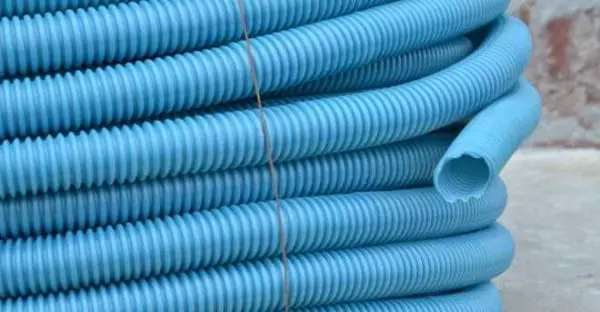
Corrugated pipes for wiring are of different colors. It is not simple, the colors have a certain meaning.
- When laying into a screed or under the floor, under the trim, the corrugation is used first, to protect against squeezing when pouring concrete, secondly, it is possible to change the cable to be able to change without damaging the floor, thirdly, to protect against damage.
- With external gasket - to protect the cable shell from atmospheric influences (ultraviolet) and mechanical damage.
- With an open gasket over the air, a corrugation is needed with a wide temperature range (so as to withstand heating and frost) and durability. To ultraviolet. If the cable is suspended, reinforcement is also necessary - to increase the bearing capacity.
- With underground laying, water resistance, as well as rigidity, is important.
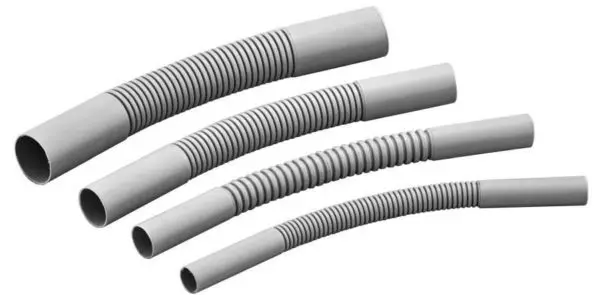
When laying hard corrugations on turns, it is better to use special couplings
In general, from mechanical destruction of corrugations, even metal, is not the best protection. You can just hope that feeling that the drill failed, it will be possible to stop on time. And to accurately not get into the wiring, it is better to have an accurate plan for its laying with measurements and reference to the corners. After all, the cable in the corrugation, even under the load, it defines not every posting detector. So do not forget before the fill of the screed, before finishing, taking pictures, sketching the slope.
Types of corrugations for cable laying
Corrugation for cable is different in strength:
- Easy. It has a thin wall and the highest degree of flexibility. Recommended for laying under the walls in the walls and on the ceilings. The mechanical load holds weakly.
- Average. Slightly thicker than light, but not so tough as hard. Can be used in the walls and in the screed. They are good in the walls, but in the screed it is better to lay a heavy corrugation.
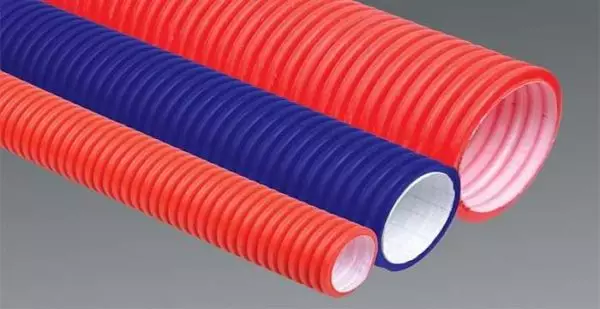
This is a double corrugation - the ribbed ribbed outside, inside the smooth. With it re-tighten the cable is not a problem
- Heavy. Thick walls, low flexibility. You can lay in the screed, bury into the ground. For turns, it is better to use corners or special couplings, since the minimum bending radius is quite large. They give a normal degree of protection both by moisture and on dust.
- Reinforced. Plastic shells are applied over the steel wire twisted into the helix. This is the best option for styling in the ground and when hanging.
In addition to all this there is another corrugation with a broach and without. Broach is a thin cable or wire that facilitates the tightening of the cable in the corrugation. The cable is tied to the end of the cable, pulls at the other end, refueling the cable inside. Without a broach, it can cope with this task problematic - with sufficient hardness, several cable meters can be simply covered inward, but if the track is long, it will be too difficult.
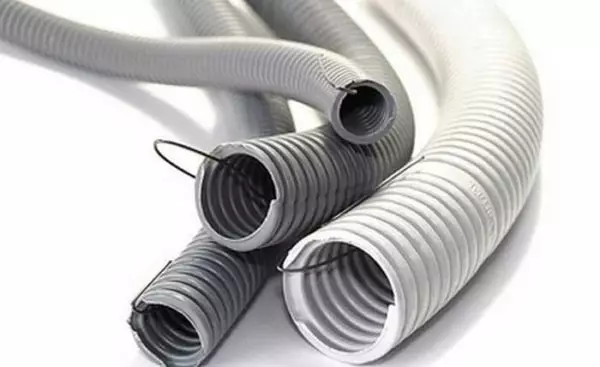
Cable corrugation can be broken (the correct name "probe") and without
If we talk about the types of plastic corrugations, you need to mention that there is a two-layer corrugation. Outside, she has the same ribbed surface, and inside it is smooth. Corrugation for cable of this species is expensive, but if necessary, you can actually stretch a new cable. In those species where the inner wall ribbed it succeeds not always - if the track has a minimum of turns, and they are on a wide range.

Metal and metal-polymer corrugation
Metal corrugation for cables is also different. It is made of galvanized or stainless steel. In addition, there is a metal corrugation with a polymer coating. It has the best characteristics of dust protection, moisture. Such a protective shell is also called metal-polymer.
From which materials
Corrugation for cable and electrical wires is made of plastic and metal. Materials are used different, with different characteristics. They must be chosen on the basis of the tasks they must perform.
- Polypropylene (PPR). In color, this corrugation is usually blue, the material is self-refining, does not support combustion. It is characterized by increased water resistance can be used for laying cables on the street or indoors with high humidity.
- PVC (polyvinyl chloride). In color - gray pipes, self-fighting. PVC corrugation is not waterproof, can only be used in dry rooms.
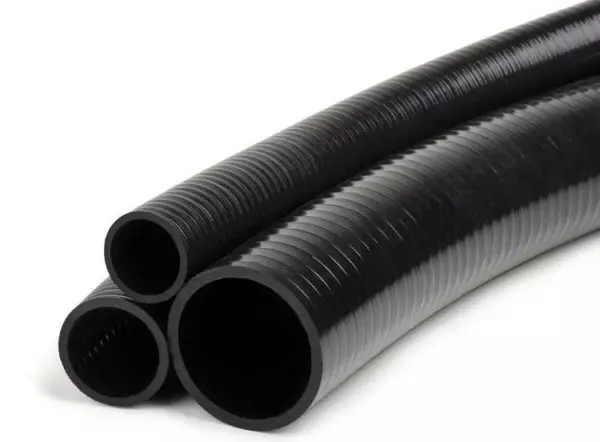
Black cable corrugation is most often made from the PND, but maybe from polypropylene (PPR)
- PND (low pressure polyethylene). Color - orange, black, material combustible, but resistant to chemical and water. Scope - gasket in the screed and strokes in non-combustible walls, an open strip on the street.
- Metal (stainless or galvanized steel). Non-combustible material, resistant to mechanical and chemical influences. Recommended for wiring in combustible buildings (wooden, frame). Also good for laying outdoors.
If we talk about compliance with the norms of fire safety when installing the gasket in combustible walls, the ideal option is a metal pipe. It saves from loads that may occur when the building size changes. It can not cope with it and rodents. Also, this is the best option from the point of view of fire safety: even when the currents of the CW and the non-disubovation of the automatic protection, the probability of burning the pipe with a wall thickness of 2 mm is very small. So the fire will not begin. If the gasket of electrical cables in the pipes does not dress at all, then you can use metal cable channels or corrugations from stainless steel or galvanized.
Corrugation Cable, Sizes, Prices
Gofrots for power grids are produced in size from 16 mm to 65 mm. When choosing a size, it is necessary to consider that these products have two diameters - external and internal. If you are going to lay a few conductors - wires or cables - the diameter should be selected so that there are no less than half of the radius. This requirement is based on the fact that with a group laying (it is necessary, by the way, take a special cable) it will be harder to warm up and the presence of the air gap will contribute to the best heat removal.
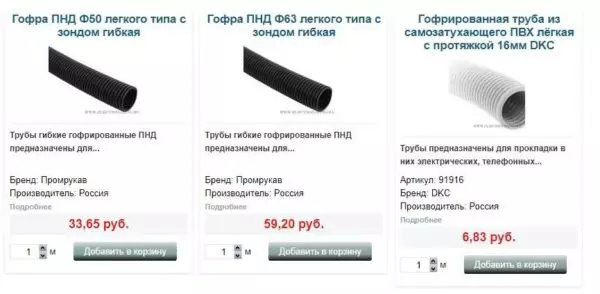
The price of corrugated electrical pipes depends on many factors
Select size
The choice of diameter of the corrugation depends on the site on which it will be laid:
- to lighting devices - 16 mm;
- to rosettes and switches - not less than 20 mm;
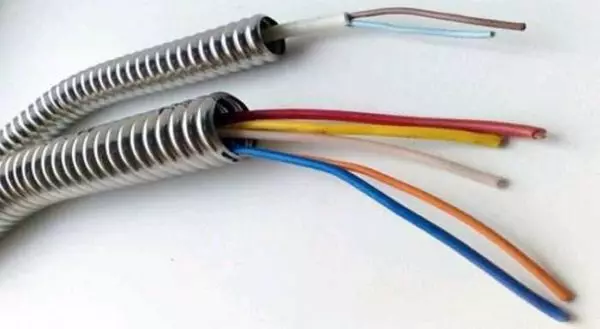
The size of the corrugation for the electrical cable is chosen depending on the number and size of the conductors
- From the main junction box until the next box, from the shield - at least 25 mm;
- The connection between two electrical panels is not less than 32 mm, and it is better to have a spare second line;
- pass through floor overlap - rigid corrugary at least 40 mm in diameter;
- Laying of low-current cables (telephone, Internet, antenna, etc.) - from 25 mm.
The diameter of the corrugation for the cable laying is selected depending on the number and cross section of the wires. Data for copper veins are shown in the table.
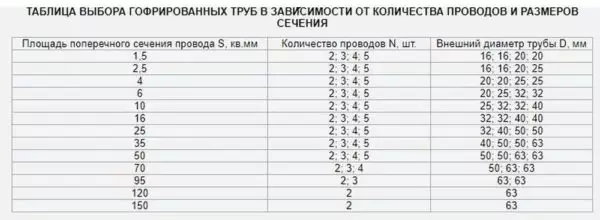
Corrugation diameter selection table for cable and wires depending on the cross section and the number of wires
This information is reference, but you can navigate. You can take a greater, but not less diameter.
Prices
If we talk in general, then the cheapest - corrugation for PVC cable, on average range - PP and PND, more expensive than all - metal. Moreover, the option with a stretch is slightly more expensive than without it. When buying, you need to pay attention to the same wall thickness, for homogeneity of color.

Different materials, colors, wall thickness and different prices
A corrugation for cable in bays of 50 and 100 meters is sold, less often can be found on meters, but the price is then slightly higher. In general, the price depends not only on the material, but also from the wall thickness. The cheapest is the light PVC corrugation for the cable, but sometimes it looks more like a film. From which such can protect, it is difficult to say. If quality is worried about, it is better to acquire everything connected with the electrician not in construction supermarkets such as Lerua, etc. And in specialized. The quality is usually better there, and the prices if higher, then reasonably. In order for you to have a possibility of a possible variation of prices, in the table we will reduce several types of corrugations with a brief technical characteristic.
| Name | A type | External diameter | Inner diameter | Broach | Price per meter | IP | Purpose |
|---|---|---|---|---|---|---|---|
| Corrugation PVC | Easy | 16 mm | 11.4 mm | Yes | 2.4 rubles | ||
| Pipe corrugated PND black | DKS. | 15.7 mm | 11.3 mm | Yes | from 7.5 rubles / m | 55. | For hidden strip |
| Pipe corrugated PND black | DKS. | 19.5 mm | 14.5 mm | Yes | from 8.9 rubles / m | 55. | For hidden wiring |
| Pipe Handy Red Bilate | Hard | 50 mm | 41.5 mm | Yes | 78.5 rub / m | 44. | For hidden strip |
| Pipe PND heavy | Heavy | 31 mm | 23.4 mm | Yes | from 9.7 rubles / m | 55. | Hidden gasket |
| PPL pipe (polypropylene) corrugated | Easy | 19.7 mm | 14.8 mm | Yes | from 28 rubles / m | 55. | Open, hidden gasket |
| Gofrotrub Polyamide | black | 21.2 mm | 16.8 mm | not | from 52 rubles / m | 68. | Open, hidden gasket, resistance to ultraviolet |
| Gofrotrub Polyamide | Gray | 21.2 mm | 16.8 mm | Yes | from 48 rubles / m | 68. | Open, hidden gasket |
Installation of corrugatedrub
With an outdoor (open) mounting for mounting corrugations for cables and wires, special plastic clips are used, which are selected for the outer diameter of the pipe. Clips are fixed after 20-30 cm on a self-tapping screw or dowel - depending on the type of wall. In the installed clips, the corrugation for Kbalay is started, pressed until it clicks. When installing in the stroke, it is fixed with plastic screeds or dowel-tie. You can also use homemade fasteners - strips of tinted with nails or self-drawing in the middle.
When developing the route, it is necessary to take into account the following recommendations. It is based on the fact that the track must be without sharp turns - in order to be able to tighten a new piece of cable if necessary. Because:
- The maximum possible length of the plot is 20-25 meters. Provided that the track has no more than 4 turns.
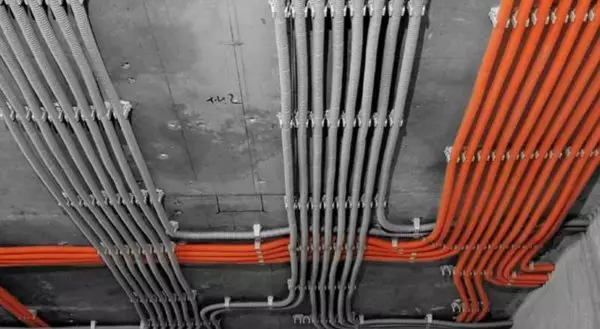
Put the electrical fluores in parallel, trying to make as few turns as possible
- Turns should not be located nearby. The distance between them is at least 4-5 meters. If there is a need to make turns nearby, it is better to put a junction box or an auditing hatch.
- The angle of rotation is at least 90 °, the radius - the more, the better.
- If the tracks for wiring and minor cables and wires come nearby, the minimum distance for laying two sleeves of corrugations is 200 mm. They can only cross at right angles.
These rules relate to the development of the route for ground (suspension) and underground cable laying, including. If the route is long, and you want the opportunity "In the event that" the cable is dragging without replacing the corrugations, develop a track taking into account these rules.
Installation of wiring in corrugation
When installing wiring in the house or apartment, pieces of corrugations are fixed between the camshafts, from them to switches / sockets, to lighting devices. Here plots are usually small, straight, maximum with one or two turns. So there are no problems with a tightening cable.
If you have to tighten the cable to the cable, it is necessary to a few conduit, they are folded, along the entire length fasten with a tape or a tape with a step of 30-50 cm (depends on the rigidity). From one edge, it is cleaned with a tight isolation by 10-15 cm, the wires are twisted into the common harness, form a loop from it (the loop will also fasten with a tape or tape). If the harness is too thick, you can form a loop separately, just through all stretch the twine. The cable is tied to this loop, and then begin to pull it from the opposite side, pulling the shell to cables. At the same time it is necessary to pull without jerks, smoothly - not to damage the cable or cable.
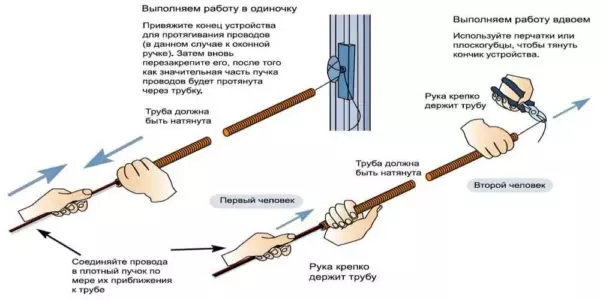
How to stretch the cable in corrugation
When installing, carefully monitor the broach not slipped. For confidence, a cable can fasten a piece of scotch. There are two approaches to mounting:
- First consolidate the corrugation, then tighten the cable or wires to the finished piece.
- First pull the cable, then mount.
The first way is good when installing internal wiring, where the distances are small - from the box to the box, from the box to the socket, etc. The second method is more suitable for the installation of prolonged sections.
Features of the open laying on the street
When laying wiring on the street it is usually suspended on a cable. Metal stainless steel is suitable for use on the street, and better - metal-polymer corrugation for cable, as well as plastic from polyamide (black or blue). All of these material have durability to ultraviolet, retain flexibility at minus temperatures.
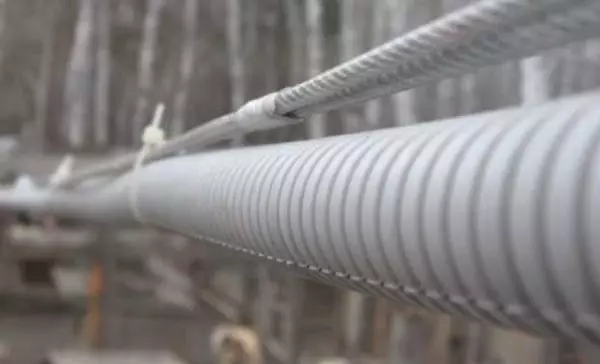
It is though a cheap way, but not the best, since ties burst
When mounting, the cable extended in the corrugation is suspended on the cable. The cheapest mount is ordinary plastic ties. There are also special suspensions.
Article on the topic: Plinth for countertops: how to put on your own hands
